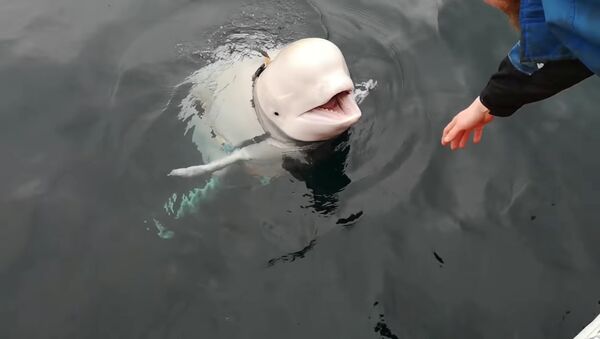In a popular vote run by Norway's national public broadcaster NRK, the beluga whale that swam into Norwegian waters last week, was called Hvaldimir, a pun that includes the Norwegian word for whale ("hval") and a popular Russian name, which has the Russian president among its bearers.
According to NRK, over 30 percent of the 25,000 people who voted, opted for "Whaledimir", a pun pioneered by the newspaper Verdens Gang in its stories about the "spy whale".
The second-popular option was Joar after the brave fisherman who jumped into the frigid Arctic waters in order to loosen the harness strapped around the whale. The spying allegations were also reflected in the third-popular option, Agent James Beluga.
While Hvaldimir's harnesses have been turned over to Norway's police intelligence unit PST for examination, PST spokesman Martin Bernsen has confirmed that the whale is not a suspect and won't be charged with espionage. However, PST admitted that it kept track of his location.
"As far as we know, the whale is still swimming somewhere around the coast near Hammerfest", Bernsen said.
READ MORE: Norway Claims to Have Caught Runaway "Spy Whale From Russia" (PHOTO, VIDEO)
Despite the fact that Russia's Defence Ministry hasn't commented on the beluga whale, the Norwegian media have been peddling the idea that "Whaledimir" escaped from a top secret Russian naval station in Murmansk, where whales allegedly are drilled for special operations with cameras or even weapons. Among others, this version has been promoted by Audun Rikardsen, a professor in freshwater and marine biology at the University of Tromsø.
"The fact that no one has claimed the whale can be a sign of that", Rikardsen told NRK. "Those who've lost him certainly know that he popped up here. When no one has come forward and said they want him back, it's a sign that maybe they don't want so much attention around this".
Rikardsen went so far as to suggest that Putin himself has been "directly involved" in training whales, citing unnamed Russian researchers.
While the "St. Petersburg" insignia on the whale's harness triggered speculations, that "Whaledimir" had bolted from Saint Petersburg, Florida, Rikardsen argued that this theory was unviable, as it would have taken a whole three months for the whale to reach Norway's coast.
READ MORE: Alleged 'Russian Spy Whale' Performing Tricks While in Norway — Reports
The Murmansk Marine Biological Institute, referenced by the Norwegian media as the likely "home" of the errant beluga, has indeed engaged in marine mammal research since the mid-1980s, but has focused its efforts on seals and sea lions, rather than belugas. In Murmansk, the animals are believed to be taught to sweep sea mines, inspect underwater equipment and pipelines, take part in search and rescue missions, and detect alien objects.
Viktor Baranets, a retired Russian colonel, claimed that the Russian special services use dolphins in their work, but ridiculed the spying allegations as "Scandinavian paranoia".
"Norwegians would probably also like to have a GRU officer's ID attached to the animal", Baranets joked. If the animal was to be used for reconnaissance purposes, the Russian Navy would certainly not attach anything to it. "Why not write phone number, 'for tips, please call here'?" Baranets smirked.
The white whale, also known as the beluga whale, is larger than a dolphin but smaller than a true whale. It is native to Arctic and sub-Arctic waters and is a close relative of the narwhal. For its intelligence and cheerful nature, belugas are commonly kept in captivity across the globe. At wildlife parks, they quickly grow tame and learn to perform different tricks.
READ MORE: Spy Whale Saga: Marine Mammals With PROVEN History of Use by Militaries (VIDEOS)


